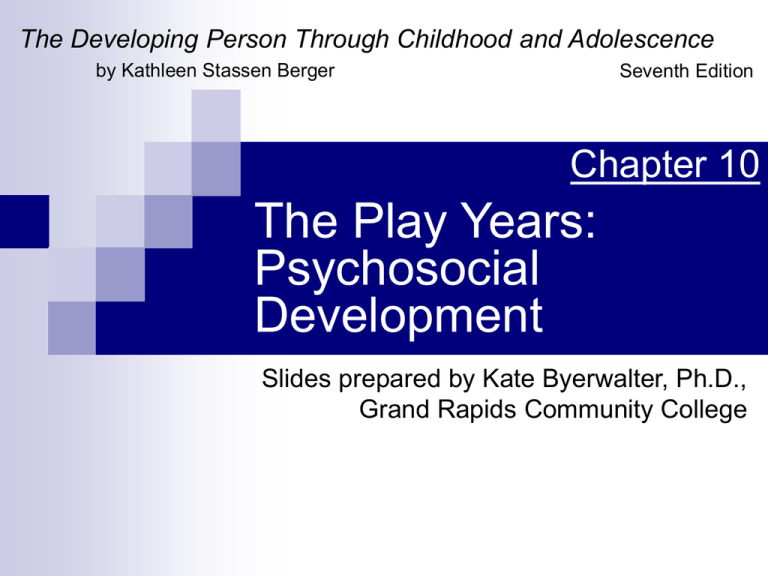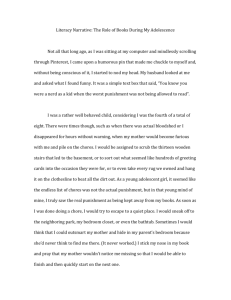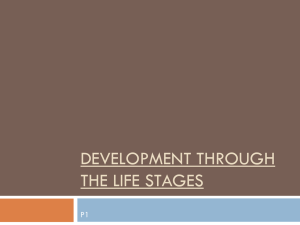
The Developing Person Through Childhood and Adolescence
by Kathleen Stassen Berger
Seventh Edition
Chapter 10
The Play Years:
Psychosocial
Development
Slides prepared by Kate Byerwalter, Ph.D.,
Grand Rapids Community College
Emotional Development
“Overall, emotional development is the
foundation that enables all the other
forms of development.…”
(Campos et al, 2004, cited on p. 285 in textbook)
Berger: The Developing Person Through Childhood and Adolescence, 7th Edition, Chapter 10
Initiative Versus Guilt
Erik Erikson’s third stage (3-6 yrs)
A child
wants to complete things
successfully, and feels guilt at failure.
Example: A child
tries to pour juice into a
cup and spills.
Some guilt is desirable.
Berger: The Developing Person Through Childhood and Adolescence, 7th Edition, Chapter 10
Pride
Young children generally have a very
positive self-concept and self-esteem.
They overestimate their abilities.
Example:
Every preschooler believes he/she
is the brightest, smartest, fastest, most liked,
best at games, etc.
Berger: The Developing Person Through Childhood and Adolescence, 7th Edition, Chapter 10
So proud!
JULIA SMITH / GETTY IMAGES
Berger: The Developing Person Through Childhood and Adolescence, 7th Edition, Chapter 10
Intrinsic Motivation
Intrinsic motivation comes from within
the individual; it is the joy of personal
accomplishment.
Adults can encourage this by not
promising rewards for a task that is
already enjoyable; instead, praise a job
well done.
Berger: The Developing Person Through Childhood and Adolescence, 7th Edition, Chapter 10
Emotional Regulation
Emotional
regulation is
learning to cope
with and direct
one’s emotions.
It develops as a
result of brain
maturation and
experiences.
PHOTODISC
Berger: The Developing Person Through Childhood and Adolescence, 7th Edition, Chapter 10
Emotional Regulation
The development of emotional regulation
is influenced by:
Genes
Early
experiences (especially stressors)
Culture
Ongoing care
Brain maturation
Gender
Attachment
Berger: The Developing Person Through Childhood and Adolescence, 7th Edition, Chapter 10
Externalizing and Internalizing
Problems
Externalizing problems occur when a
child turns emotional distress outward
(e.g., attacking others in anger).
Internalizing problems occur when a
child turns emotional distress inward (e.g.,
becoming anxious or withdrawn).
Berger: The Developing Person Through Childhood and Adolescence, 7th Edition, Chapter 10
Emotional Intelligence
Emotional Intelligence involves learning
how to interpret and express emotions.
As the prefrontal cortex develops,
children’s ability to regulate emotions
improves.
Caregivers also play a role in teaching
emotional intelligence.
Berger: The Developing Person Through Childhood and Adolescence, 7th Edition, Chapter 10
Empathy and Antipathy
Empathy: a true understanding of the
feelings and concerns of another
This
results in prosocial behavior (e.g.,
helpful, kind) and is helped by theory of
mind.
Antipathy: a dislike or hatred of people
Results
in antisocial behavior (e.g.,
aggressive).
Berger: The Developing Person Through Childhood and Adolescence, 7th Edition, Chapter 10
Brotherly
Love
JEFF GREENBERG / THE IMAGE WORKS
Berger: The Developing Person Through Childhood and Adolescence, 7th Edition, Chapter 10
Make it Real: Empathy
In what ways can caregivers help children
learn empathy? Think of specific ideas.
Berger: The Developing Person Through Childhood and Adolescence, 7th Edition, Chapter 10
Preference and Prejudice
Young children are
able to show pride
in their own “group”
while avoiding
prejudice of others.
KATE BYERWALTER
Berger: The Developing Person Through Childhood and Adolescence, 7th Edition, Chapter 10
The Importance of Play
It is natural and beneficial for young
children to PLAY!
Jean Piaget said “Play is the work of the
child.”
Children LEARN through play (and also
relieve stress).
Berger: The Developing Person Through Childhood and Adolescence, 7th Edition, Chapter 10
Types of Play
Solitary = play alone
Onlooker = watch others
Parallel = play with similar toys in
similar ways, but don’t interact
Associative = interact and share
emotions, but not in same game (e.g.,
outdoor play)
Berger: The Developing Person Through Childhood and Adolescence, 7th Edition, Chapter 10
Types of Play (cont.)
Cooperative = play together, with
common goal, taking turns (e.g.,
Checkers)
Rough and tumble = mimics aggression,
but is in fun (“play face”)
It
usually requires social experience among
participants, and enough physical space to
play.
Berger: The Developing Person Through Childhood and Adolescence, 7th Edition, Chapter 10
Quiz: How do you know this
isn’t an aggressive encounter?
LAURA DWIGHT
Berger: The Developing Person Through Childhood and Adolescence, 7th Edition, Chapter 10
Importance of Play: Part II
It is imperative that society continues to
value the importance of all types of play
among young children.
Intellectual development is certainly
important in early childhood, but so is
ample time for free, unstructured play!
Berger: The Developing Person Through Childhood and Adolescence, 7th Edition, Chapter 10
Types of Play (cont.)
Sociodramatic Play = Pretend play in
which children act out self-created roles
and themes
Examples: Playing house, doctor,
superheroes, or school
Think: why might children enjoy this type
of play? What benefits might there be?
Berger: The Developing Person Through Childhood and Adolescence, 7th Edition, Chapter 10
Types of Play (cont.)
Sociodramatic play helps children:
Explore
and rehearse social roles they
have observed (e.g., playing the “Dad”)
Regulate
emotions through imagination
(e.g., the powerful feeling of being a
superhero)
Learn
to negotiate and cooperate with others
Berger: The Developing Person Through Childhood and Adolescence, 7th Edition, Chapter 10
Quiz: What type of play is this?
FELICIA MARTINEZ / PHOTOEDIT, INC.
Berger: The Developing Person Through Childhood and Adolescence, 7th Edition, Chapter 10
Make it Real: Coping with Anger
What can
caregivers do to
help children cope
with anger, and
lessen the amount
of aggression
children display?
LAURA DWIGHT
Berger: The Developing Person Through Childhood and Adolescence, 7th Edition, Chapter 10
Aggression
All children experience the emotion of
anger, but aggression involves hostile
attitudes and hurtful, destructive behavior
towards others.
Some types of aggression are more
troublesome and long-lasting than others
(see next slide).
Berger: The Developing Person Through Childhood and Adolescence, 7th Edition, Chapter 10
Types of Aggression
Instrumental: Used to obtain an object
such as a toy
This
is common among young children, and
becomes less prevalent with age.
Reactive: Retaliation for an act, whether
or not it was intentional
This
indicates a lack of emotional regulation.
Berger: The Developing Person Through Childhood and Adolescence, 7th Edition, Chapter 10
Types of Aggression (cont.)
Relational: Insults or social rejection
intended to hurt another
Example:
“You can’t come to my party.”
Bullying: Unprovoked, repeated attack to
inflict physical or mental harm
Berger: The Developing Person Through Childhood and Adolescence, 7th Edition, Chapter 10
Berger: The Developing Person Through Childhood and Adolescence, 7th Edition, Chapter 10
Make it Real: Parenting
In your opinion,
how influential is a
parent to a child’s
development?
PHOTODISC
Berger: The Developing Person Through Childhood and Adolescence, 7th Edition, Chapter 10
Parenting Styles
Diana Baumrind found that parents differ
on four dimensions of parenting:
Expressions
Strategies
Quality
of warmth
for discipline
of communication
Expectations
for maturity
Berger: The Developing Person Through Childhood and Adolescence, 7th Edition, Chapter 10
Authoritative Style
High Warmth
High level of communication
Moderate expectations for maturity
Discipline strategies involve much
discussion, firm but fair limits
Berger: The Developing Person Through Childhood and Adolescence, 7th Edition, Chapter 10
Authoritarian Style
Little Warmth
Communication is one way (commands of
parent)
Very high expectations for maturity
Strict, often physical discipline strategies
Berger: The Developing Person Through Childhood and Adolescence, 7th Edition, Chapter 10
Permissive Style
High warmth
High amount of communication
Few to no expectations
Little to no discipline
Berger: The Developing Person Through Childhood and Adolescence, 7th Edition, Chapter 10
Berger: The Developing Person Through Childhood and Adolescence, 7th Edition, Chapter 10
Parenting Styles: Quick Review
Suppose a teenager came in late for curfew…
How would each of Baumrind’s 3 main
parenting styles handle the situation?
Berger: The Developing Person Through Childhood and Adolescence, 7th Edition, Chapter 10
Outcomes of Parenting Styles
Which parenting style would you guess is
associated with the following outcomes?
Children
are obedient, not happy
Children lack self-control, are not happy
Children are successful, articulate, intelligent,
and happy
Berger: The Developing Person Through Childhood and Adolescence, 7th Edition, Chapter 10
Outcomes of Parenting Styles
Authoritarian: Children are obedient, not
especially happy
Permissive: Children lack self-control, are
the least happy
Authoritative: Children are successful,
articulate, intelligent, and happy
Berger: The Developing Person Through Childhood and Adolescence, 7th Edition, Chapter 10
Berger: The Developing Person Through Childhood and Adolescence, 7th Edition, Chapter 10
Make it Real: Discipline
Anyone working with
young children needs
to have a set of tools
in mind for discipline.
What discipline
strategies have you
heard about or used?
LAURA DWIGHT
Berger: The Developing Person Through Childhood and Adolescence, 7th Edition, Chapter 10
Discipline Strategies
No one strategy is a “cure-all.”
Techniques are often rooted in culture
(e.g., time-out is popular in the U.S.).
All strategies should consider a child’s
emerging self-concept and level of
cognitive development.
Berger: The Developing Person Through Childhood and Adolescence, 7th Edition, Chapter 10
Berger: The Developing Person Through Childhood and Adolescence, 7th Edition, Chapter 10
© THE NEW YORKER COLLECTION 2002 BARBARA SMALLER FROM CARTOON
BANK.COM. ALL RIGHTS RESERVED.
The Challenge of Media
Berger: The Developing Person Through Childhood and Adolescence, 7th Edition, Chapter 10
Question: The Challenge of Media
Take a guess:
How much time a day do you think the
average child under 8 years old spends
watching TV or playing video games or
computer?
Berger: The Developing Person Through Childhood and Adolescence, 7th Edition, Chapter 10
Berger: The Developing Person Through Childhood and Adolescence, 7th Edition, Chapter 10
The Challenge of Media (cont.)
Most U.S. children spend over 3 hours a
day using media.
By age 3, over 25% of children have a TV
in their bedroom.
75% of low-income and 83% of higherincome children have cable TV.
Berger: The Developing Person Through Childhood and Adolescence, 7th Edition, Chapter 10
Techno Homes–The Typical
Child’s Home Contains:
Berger: The Developing Person Through Childhood and Adolescence, 7th Edition, Chapter 10
The Challenge of Media (cont.)
Several U.S. organizations have issued
statements imploring parents to reduce
children’s exposure to violent media.
Longitudinal studies have established a
link between TV violence in childhood and
grades in high school.
Berger: The Developing Person Through Childhood and Adolescence, 7th Edition, Chapter 10
The Challenge of Media (cont.)
Overuse of the
media takes away
time for imaginative
and social play, and
reduces time for
parent-child
interaction.
PHOTODISC
Berger: The Developing Person Through Childhood and Adolescence, 7th Edition, Chapter 10
Question: Boy or Girl─So What?
Are males really from Mars, and females
from Venus?
If yes, what makes males and females
think, act, and feel differently?
If no, are gender differences simply
exaggerated?
Berger: The Developing Person Through Childhood and Adolescence, 7th Edition, Chapter 10
Boy or Girl: So What?
Sex differences = biological differences
between males and females
Gender differences = culturally imposed
differences in the roles and behaviors of
males and females
Berger: The Developing Person Through Childhood and Adolescence, 7th Edition, Chapter 10
Developmental Progression of
Gender Awareness
By age 2 cognitive awareness of gender;
gender-related preferences and play patterns
are apparent
By age 3 rudimentary awareness that gender
distinctions are lifelong
By age 4 awareness of “gender-appropriate”
toys and roles
By age 6 well-formed ideas and prejudices
about own and other sex
Berger: The Developing Person Through Childhood and Adolescence, 7th Edition, Chapter 10
Theories of Gender Differences
Psychoanalytic Theory (Freud)
Phallic
stage = third stage of psychosexual
development
Identification
= defense mechanism that lets a
person symbolically take on behaviors and
attitudes of someone more powerful than
himself or herself
Superego
= personality part that is self-critical
and judgmental
Berger: The Developing Person Through Childhood and Adolescence, 7th Edition, Chapter 10
Theories of Gender Differences (cont.)
Oedipus (boys), Electra (girls) complexes
of phallic stage
Child
develops sexual feelings toward oppositesex parent, wants to replace same-sex parent
Child
cannot replace same-sex parent, so wants
to be like that parent
Guilt
and fear are resolved by genderappropriate behavior
No
longer a popular theory–often same-sex
parent not present
Berger: The Developing Person Through Childhood and Adolescence, 7th Edition, Chapter 10
Behaviorist Theory of Gender
Gender roles are
learned through
observation and
imitation.
Examples:
Who
takes out the
garbage? Who
writes thank you
notes? etc.
RONNIE KAUFMAN / CORBIS
Berger: The Developing Person Through Childhood and Adolescence, 7th Edition, Chapter 10
Cognitive Theory of Gender
Gender schemas organize the world into
“male” and “female” activities.
This is guided by an internal motivation to
conform to sociocultural standards of
gender.
Example:
“Is this a (boy/girl) thing to do?”
Berger: The Developing Person Through Childhood and Adolescence, 7th Edition, Chapter 10
Sociocultural Theory of
Gender
Children learn the preferred behavior for
men and women in their society.
Androgyny = a healthy balance of male
and female psychological characteristics
Is
considered a psychologically healthy way
to be, and will most fully occur if society
supports it
Berger: The Developing Person Through Childhood and Adolescence, 7th Edition, Chapter 10
Epigenetic systems theory
of gender
Gender typed behavior is shaped by
BOTH genetic differences between
male and female brains, and
environmental influences
Berger: The Developing Person Through Childhood and Adolescence, 7th Edition, Chapter 10







